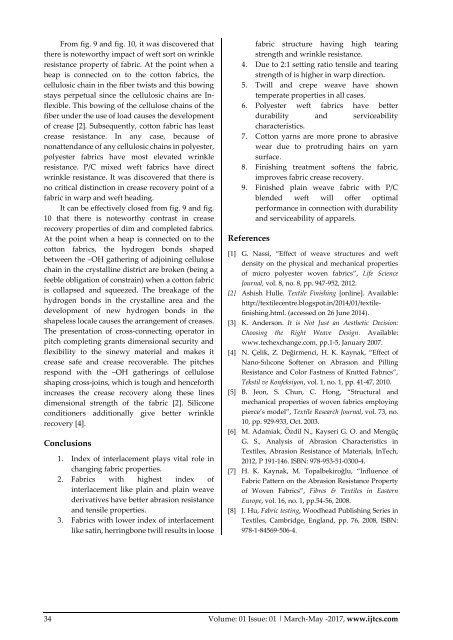IJTCS Vol.-1 Issue-1 March-May, 2017
The Indian Journal of Textile and Clothing Science (IJTCS) is a peer reviewed (refereed) national journal (India). Which is aimed at providing platform to exchange information pertaining to all sectors of textile and the clothing industry among researchers, textile technocrats, fashion designers and industrial experts. The journal focuses on scientific, technical, economical, managerial and all other aspects of textile activity at theoretical and experimental level. IJTCS is aimed at publishing original research articles, review papers, short communications, and letters to the editor and book reviews catering the needs of both industry and academia.
The Indian Journal of Textile and Clothing Science (IJTCS) is a peer reviewed (refereed) national journal (India). Which is aimed at providing platform to exchange information pertaining to all sectors of textile and the clothing industry among researchers, textile technocrats, fashion designers and industrial experts.
The journal focuses on scientific, technical, economical, managerial and all other aspects of textile activity at theoretical and experimental level. IJTCS is aimed at publishing original research articles, review papers, short communications, and letters to the editor and book reviews catering the needs of both industry and academia.
You also want an ePaper? Increase the reach of your titles
YUMPU automatically turns print PDFs into web optimized ePapers that Google loves.
From fig. 9 and fig. 10, it was discovered that<br />
there is noteworthy impact of weft sort on wrinkle<br />
resistance property of fabric. At the point when a<br />
heap is connected on to the cotton fabrics, the<br />
cellulosic chain in the fiber twists and this bowing<br />
stays perpetual since the cellulosic chains are Inflexible.<br />
This bowing of the cellulose chains of the<br />
fiber under the use of load causes the development<br />
of crease [2]. Subsequently, cotton fabric has least<br />
crease resistance. In any case, because of<br />
nonattendance of any cellulosic chains in polyester,<br />
polyester fabrics have most elevated wrinkle<br />
resistance. P/C mixed weft fabrics have direct<br />
wrinkle resistance. It was discovered that there is<br />
no critical distinction in crease recovery point of a<br />
fabric in warp and weft heading.<br />
It can be effectively closed from fig. 9 and fig.<br />
10 that there is noteworthy contrast in crease<br />
recovery properties of dim and completed fabrics.<br />
At the point when a heap is connected on to the<br />
cotton fabrics, the hydrogen bonds shaped<br />
between the –OH gathering of adjoining cellulose<br />
chain in the crystalline district are broken (being a<br />
feeble obligation of constrain) when a cotton fabric<br />
is collapsed and squeezed. The breakage of the<br />
hydrogen bonds in the crystalline area and the<br />
development of new hydrogen bonds in the<br />
shapeless locale causes the arrangement of creases.<br />
The presentation of cross-connecting operator in<br />
pitch completing grants dimensional security and<br />
flexibility to the sinewy material and makes it<br />
crease safe and crease recoverable. The pitches<br />
respond with the –OH gatherings of cellulose<br />
shaping cross-joins, which is tough and henceforth<br />
increases the crease recovery along these lines<br />
dimensional strength of the fabric [2]. Silicone<br />
conditioners additionally give better wrinkle<br />
recovery [4].<br />
Conclusions<br />
1. Index of interlacement plays vital role in<br />
changing fabric properties.<br />
2. Fabrics with highest index of<br />
interlacement like plain and plain weave<br />
derivatives have better abrasion resistance<br />
and tensile properties.<br />
3. Fabrics with lower index of interlacement<br />
like satin, herringbone twill results in loose<br />
fabric structure having high tearing<br />
strength and wrinkle resistance.<br />
4. Due to 2:1 setting ratio tensile and tearing<br />
strength of is higher in warp direction.<br />
5. Twill and crepe weave have shown<br />
temperate properties in all cases.<br />
6. Polyester weft fabrics have better<br />
durability and serviceability<br />
characteristics.<br />
7. Cotton yarns are more prone to abrasive<br />
wear due to protruding hairs on yarn<br />
surface.<br />
8. Finishing treatment softens the fabric,<br />
improves fabric crease recovery.<br />
9. Finished plain weave fabric with P/C<br />
blended weft will offer optimal<br />
performance in connection with durability<br />
and serviceability of apparels.<br />
References<br />
[1] G. Nassi, “Effect of weave structures and weft<br />
density on the physical and mechanical properties<br />
of micro polyester woven fabrics”, Life Science<br />
Journal, vol. 8, no. 8, pp. 947-952, 2012.<br />
[2] Ashish Hulle. Textile Finishing [online]. Available:<br />
http://textilecentre.blogspot.in/2014/01/textilefinishing.html.<br />
(accessed on 26 June 2014).<br />
[3] K. Anderson. It is Not Just an Aesthetic Decision:<br />
Choosing the Right Weave Design. Available:<br />
www.techexchange.com, pp.1-5, January 2007.<br />
[4] N. Çelik, Z. Değirmenci, H. K. Kaynak, “Effect of<br />
Nano-Sılıcone Softener on Abrasıon and Pilling<br />
Resistance and Color Fastness of Knıtted Fabrıcs”,<br />
Tekstil ve Konfeksiyon, vol. 1, no. 1, pp. 41-47, 2010.<br />
[5] B. Jeon, S. Chun, C. Hong, “Structural and<br />
mechanical properties of woven fabrics employing<br />
pierce’s model”, Textile Research Journal, vol. 73, no.<br />
10, pp. 929-933, Oct. 2003.<br />
[6] M. Adamiak, Özdil N., Kayseri G. O. and Mengüç<br />
G. S., Analysis of Abrasion Characteristics in<br />
Textiles, Abrasion Resistance of Materials, InTech,<br />
2012, P 191-146. ISBN: 978-953-51-0300-4.<br />
[7] H. K. Kaynak, M. Topalbekiroğlu, “Influence of<br />
Fabric Pattern on the Abrasion Resistance Property<br />
of Woven Fabrics”, Fibres & Textiles in Eastern<br />
Europe, vol. 16, no. 1, pp.54-56, 2008.<br />
[8] J. Hu, Fabric testing, Woodhead Publishing Series in<br />
Textiles, Cambridge, England, pp. 76, 2008, ISBN:<br />
978-1-84569-506-4.<br />
34 <strong>Vol</strong>ume: 01 <strong>Issue</strong>: 01 | <strong>March</strong>-<strong>May</strong> -<strong>2017</strong>, www.ijtcs.com



